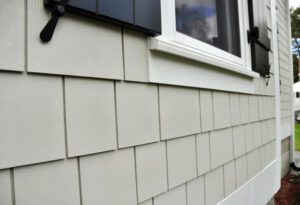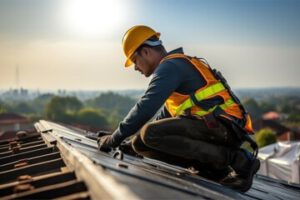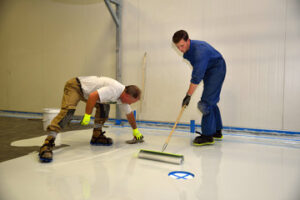The exterior of your home is constantly under attack by the elements. Rain, snow, sun, wind, insects, rodents, and even the occasional accidentally thrown baseball can leave behind damage that requires costly repairs or replacement. Visit Siding Companies Charleston SC for more information.
Cement siding, fiber cement siding, or Hardie board offers enhanced durability that protects your home and minimizes maintenance. This makes it an excellent choice for a wide range of climates.

Cement siding is durable and stands up to a variety of weather conditions. It is less susceptible to rot and sun damage and is a great choice for homeowners who want to improve their home’s appearance without spending much money. It also does not easily fade in the bright Virginia sunshine like other types of siding. In addition, it is resistant to mold and mildew and won’t attract termites as wood siding can. It is also fire resistant and holds up well to impact damage, meaning you can feel confident that your home will withstand harsh weather.
Fiber cement siding is made from a mix of concrete, sand, and water with additional additives such as wood pulp or fly ash to strengthen the material and increase its durability. It came onto the market in the 1980s as a replacement for asbestos siding and is available from manufacturers such as James Hardie. The product can be painted on-site or prepainted and is moisture, rot, and insect-resistant. It is also energy efficient and contributes to your home’s insulation.
The most common application for fiber cement siding is cladding on homes, although it can be used on other parts of your house as an accent or on porches or decks. It is an excellent alternative to natural materials such as brick or stone and offers a look that many people find very appealing. The material is manufactured to mimic the grain and surface of raw materials and has a textured finish that replicates the slight irregularities of real wood products. It is also easy to paint and will hold the paint very well.
Cement siding is heavy and requires professional installation, but it is a relatively low-maintenance product. It must be repainted every 5 to 12 years, depending on whether you choose an unfinished or prepainted product. Cutting fiber cement releases respirable crystalline silica, so working in a well-ventilated area and using a mask when installing is important.
As a homeowner, it’s important to find exterior building materials that match the aesthetics of your home. Whether trying to create a modern look, rustic charm, or an eclectic mix-media approach, fiber cement siding can help make it a reality. The material is available in various colors and textures that mimic natural materials, allowing you to achieve the perfect visual finish.
The material can also be used as a durable backerboard, helping beautify and protect your home’s eaves and soffits. Soffits are essential to your home’s roof system, providing advanced protection against moisture penetration and insect infestation. They are also a great place to add an eye-catching design element that stands out from the rest of your home’s exterior.
Cement beadboard is another siding option that can help improve the appearance of your home’s eaves and soffits. It can be stained or painted to complement your home’s exterior and offer advanced resistance against moisture and insects. This siding style is often used instead of traditional wood beadboard for its strength and durability.
Many homeowners are concerned about the flammability of their siding. Fortunately, most fiber cement siding products are non-flammable and do not contribute to a fire. This is a major benefit, especially for those who live in historic districts that limit the types of building materials that can be used.
Multiple siding styles can be created with fiber cement, including clapboards, shake shingles, and HardiePlank lap siding. These options offer the versatility to suit any architectural style. Clapboards feature clean lines that work well on classic and modern homes. Shake shingles are popular for those looking to add texture and dimension to their home. The material can even look weathered to replicate a more rustic style.
Depending on the type of fiber cement siding you choose, it may be available in various textures and prefinished colors. These finishes are designed to mimic the slight imperfections of natural wood grain and can add an attractive finished look to your home’s exterior.
Cement siding is much more energy-efficient than other types of exterior materials. It insulates a home better, and that helps to lower energy costs all year. It’s also environmentally friendly since lowering energy usage reduces carbon emissions.
Fiber cement can withstand harsh conditions that damage or warp other siding materials. It’s impervious to moisture, rain, snow, wind, heat, sunlight, rodents, and insects. This makes it perfect for humid seaside or coastal areas, arid mountainous regions, and wildfire-prone zones.
Unlike wood or vinyl, fiber cement siding contains no organic material susceptible to rot. It also won’t be damaged by hail, sleet, or other forms of extreme weather. It can withstand impact from flying objects like the occasional baseball neighborhood kids toss during a backyard game.
The mix of ash and cement in fiber cement siding wards off termites and other pests that wreak havoc on traditional, vulnerable sidings. This prevents costly infestations and gives homeowners peace of mind when protecting their investment.
Fiber cement is less prone to cracking and fading than traditional siding, and it’s easier to clean and maintain. It’s a smart choice for any homeowner who wants to increase their home’s value and curb appeal while enjoying long-term cost savings.
If you’re considering installing fiber cement siding, contacting a professional installer is a good idea. They’ll have the tools and knowledge to perform a mistake-free installation free of performance issues like water infiltration or premature deterioration. A skilled contractor can also touch up any blemishes while handling and transporting the material.
Many homeowners choose to install their fiber cement siding as an affordable alternative to hiring a professional installer. However, the materials can be heavy and require a high skill level to handle safely. They can also give off silicosis-causing silica dust, so proper safety equipment and training are essential for anyone attempting to DIY. When installed correctly by a professional, fiber cement is a beautiful and durable addition to any home.
Fiber cement siding is extremely durable and easy to maintain. It is resistant to fire, rot, insects, salt, and fading from the sun. It comes in various colors and styles and can be prepainted or left unpainted. If you choose to paint your fiber cement, it should last 15 years before needing repainting, depending on the climate where you live.
To clean your fiber cement siding:
- Wash it with a mild liquid dishwashing soap and water.
- Get the surface wet, and wash it with a soft brush or cloth in a side-to-side motion.
- Avoid abrasive cleaners, as they can scratch the surface.
- After cleaning, rinse the surface with a garden hose to remove any soap residue. If you need to use a pressure washer, do not use high water pressure, and always use a wide tip at a distance of six feet or more from the surface.
High pressure can damage your siding.
You may need to scrub a bit harder for oil, mold, or mildew stains, which require a scrubbing brush or rag dampened with a little dishwashing soap. Do not scrub with an abrasive brush, as this could scratch the surface of your siding, which any warranty will not cover.
In addition to regular cleaning, inspecting the caulking used by contractors for installation is a good idea. The caulking helps prevent moisture from entering the wall and seals the gap between the home and the foundation. If the caulking has cracked or becomes brittle, you can easily repair it with silicone caulking.
Companies like James Hardie, Allura, and Nichiha make the best brands of fiber cement siding. Many of these products mimic the look of natural wood, and they can be painted to match your home’s color scheme. They are a popular choice among environmentally conscious homeowners since the materials do not need to be harvested from trees, contributing to deforestation.
While homeowners can install their fiber cement siding, it is better left to professionals with the proper equipment and knowledge. This includes the right tools, such as a circular saw with carbide blades and diamond tips for clean cuts, and carpentry tools like a Speed square, level, and chalk line. In addition, cutting the material can produce silicosis-causing silica dust, and professionals are familiar with proper safety protocols.


